胸外科病例讨论英文版
- 格式:ppt
- 大小:1.20 MB
- 文档页数:13

第7期疑难病例讨论患儿,性别男,年龄4月,因“咳嗽喘息10天,加重伴气促4天”于2017.08.20入院。
临床表现:患儿于10天前出现咳嗽,为阵发性干咳,伴喘息,伴有喉鸣,咳嗽剧烈时并有阵发性面色发红现象,无发热,无气促发绀,起病后在家口服药物治疗(抗病毒口服液、小儿氨酚黄那敏颗粒、咳喘灵颗粒),无明显好转,4天前出现加重,伴有气促,无发绀,遂在当地A院住院治疗(具体诊治不详)4天,无缓解,咳嗽较前明显增多,遂到“A院”就诊,完善心脏彩超提示“先天性心脏病”,建议家属上级医院进诊治,为求进一步诊治至B院就诊。
起病以来患儿精神反应一般,食欲差,睡眠差,哭吵不安,目前有腹泻,解黄绿色稀水便,3-4次/天,小便量可。
入院体查:SPO2:90%.发育正常,营养不良,急性面容,自主体位,哭吵,神志清楚,查体不合作。
肤色粉红,肤色全身皮肤粘膜无黄染,弹性正常,无皮疹、皮下出血、皮下结节、瘢痕,无肝掌、蜘蛛痣,皮下无水肿,毛发分布正常,无溃疡。
全身浅表淋巴结无肿大。
头颅无畸形、压痛、包块,前囟平软,1.0cm×1.0cm,无眼睑水肿,结膜正常,眼球正常,巩膜无黄染,瞳孔等大同圆,直径2.5mm,对光反射正常,外耳道无异常分泌物,乳突无压痛,口唇无发绀,口腔粘膜正常。
咽部粘膜充血,扁桃体无肿大,腮腺正常。
颈软无抵抗,颈动脉搏动正常,颈静脉正常,气管居中,肝颈静脉回流征阴性,甲状腺正常,无压痛、震颤、血管杂音。
胸廓正常,胸骨无叩痛,乳房正常对称。
呼吸运动正常,肋间隙正常,叩诊清音,呼吸规整,呼吸急促,可见三凹征。
双肺呼吸音粗,可闻及哮鸣音,无胸膜摩擦音。
心前区无隆起,心尖搏动点左乳线处,心尖搏动正常,无心包摩擦感。
心率156次/分、心律齐、心音有力、各瓣膜区可闻及4/6级收缩期吹风样杂音,有传导、无心包摩擦音。
腹平坦,无腹壁静脉曲张,腹部柔软,无压痛、反跳痛,腹部无包块。
肝脏未触及,脾脏未触及,肾脏无叩击痛,无移动性浊音。

英文病例写作范文阅读带翻译病例写作是医生日常的工作,英文的病例该如何写呢,接下来店铺为大家整理英文病例写作范文,希望对你有帮助哦!英文病例写作范文篇一Name: Joe Bloggs (姓名:乔。
伯劳格斯)Date: 1st January 2000(日期:2000年1月1日)Time: 0720(时间:7时20分)Place: A&E(地点:事故与急诊登记处)Age: 47 years(年龄:47岁)Sex: male(性别:男)Occupation: HGV(heavy goods vehicle ) driver(职业:大型货运卡车司机)PC(presenting complaint)(主诉)4-hour crushing retrosternal chest pain(胸骨后压榨性疼痛4小时)HPC(history of presenting complaint)(现病史)Onset: 4 hours of “crushing tight” retrosternal chest pain, radiating to neck and both arms, gradual onset over 5-10 minutes.(起病特征:胸骨后压榨性疼痛4小时,向颈与双臂放射,5-10分钟内渐起病)Duration: persistent since onset(间期:发病起持续至今)Severe: “worst pain ever had”(严重性:“从未痛得如此厉害过)Relieving/exacerbating factors缓解与恶化因素GTN(glyceryl trinitrate) provided no relief although normally relieves pain in minutes, no other relieving/exacerbating factors.(硝酸甘油平时能在数分钟内缓解疼痛,但本次无效,无其它缓解和恶化因素。


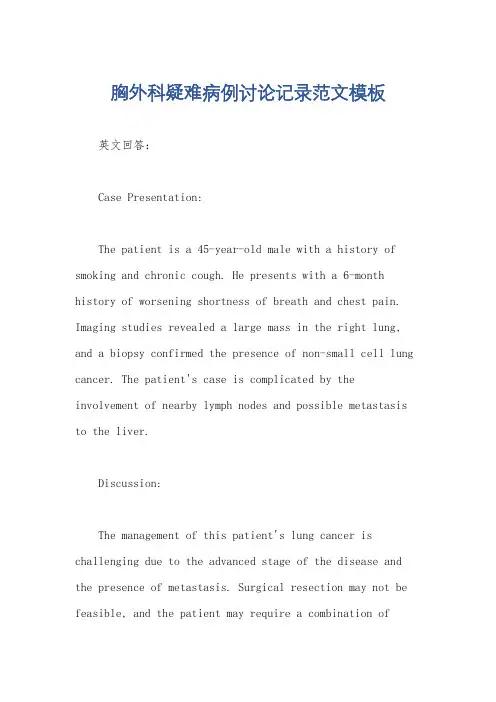
胸外科疑难病例讨论记录范文模板英文回答:Case Presentation:The patient is a 45-year-old male with a history of smoking and chronic cough. He presents with a 6-month history of worsening shortness of breath and chest pain. Imaging studies revealed a large mass in the right lung, and a biopsy confirmed the presence of non-small cell lung cancer. The patient's case is complicated by the involvement of nearby lymph nodes and possible metastasis to the liver.Discussion:The management of this patient's lung cancer is challenging due to the advanced stage of the disease and the presence of metastasis. Surgical resection may not be feasible, and the patient may require a combination ofchemotherapy, radiation therapy, and targeted therapy. The involvement of a multidisciplinary team including medical oncologists, radiation oncologists, and thoracic surgeonsis essential for developing an individualized treatment plan.English response:The patient's smoking history and the advanced stage of the disease pose significant challenges in the managementof his lung cancer. It will be important to discuss the potential benefits and risks of different treatment options with the patient and involve him in shared decision-making. Palliative care should also be considered to address the patient's symptoms and improve his quality of life.中文回答:患者的吸烟史和疾病的晚期阶段使他的肺癌治疗面临重大挑战。

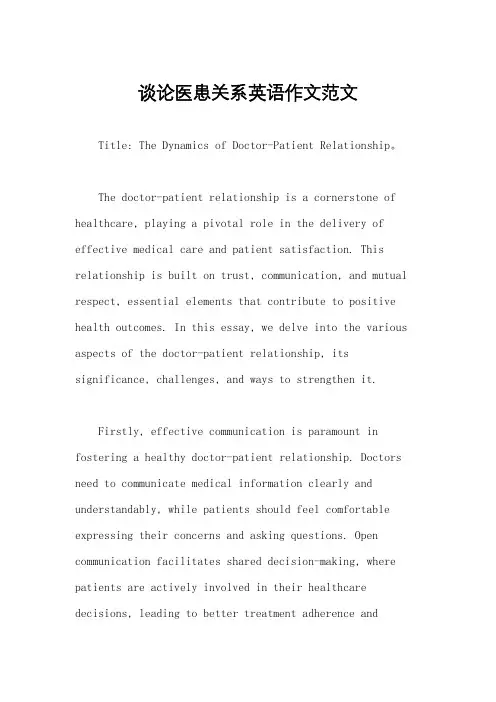
谈论医患关系英语作文范文Title: The Dynamics of Doctor-Patient Relationship。
The doctor-patient relationship is a cornerstone of healthcare, playing a pivotal role in the delivery of effective medical care and patient satisfaction. This relationship is built on trust, communication, and mutual respect, essential elements that contribute to positive health outcomes. In this essay, we delve into the various aspects of the doctor-patient relationship, its significance, challenges, and ways to strengthen it.Firstly, effective communication is paramount in fostering a healthy doctor-patient relationship. Doctors need to communicate medical information clearly and understandably, while patients should feel comfortable expressing their concerns and asking questions. Open communication facilitates shared decision-making, where patients are actively involved in their healthcare decisions, leading to better treatment adherence andoutcomes.Furthermore, trust forms the foundation of the doctor-patient relationship. Patients entrust their health and well-being to their doctors, relying on their expertise and judgment. Trust is cultivated through consistent, compassionate care, respect for patient autonomy, and maintaining confidentiality. Conversely, breaches of trust, such as medical errors or lack of empathy, can erode the patient's confidence and strain the relationship.Empathy is another crucial component of the doctor-patient relationship. Empathetic doctors can understand and resonate with their patients' emotions, offering not just medical expertise but also emotional support. Patients appreciate doctors who demonstrate empathy, feeling heard and understood amidst their health concerns. Empathy humanizes the medical encounter, fostering a connectionthat transcends the purely clinical aspect.However, despite its importance, the doctor-patient relationship faces various challenges in today's healthcarelandscape. Time constraints, administrative burdens, and the pressure to meet productivity targets can hinder meaningful doctor-patient interactions. In some cases, cultural and language barriers may impede effective communication, leading to misunderstandings and dissatisfaction.Moreover, the hierarchical nature of the healthcare system can create power imbalances within the doctor-patient relationship. Patients may feel intimidated or hesitant to question their doctors, fearing repercussions or being perceived as difficult. Addressing these power differentials requires a shift towards patient-centered care, where patients are viewed as partners in their healthcare journey rather than passive recipients of medical advice.To strengthen the doctor-patient relationship, healthcare organizations can implement various strategies. Investing in communication skills training for healthcare providers can enhance their ability to engage with patients effectively. Emphasizing patient-centered care in medicaleducation curriculum can instill values of empathy, communication, and shared decision-making in future healthcare professionals.Additionally, integrating technology into healthcare delivery can facilitate communication and streamline administrative processes, allowing more time for meaningful patient interactions. Telemedicine platforms, patient portals, and electronic health records can improve accessto care, enhance communication between doctors and patients, and empower patients to take an active role in managingtheir health.In conclusion, the doctor-patient relationship is a cornerstone of healthcare, characterized by trust, communication, and empathy. Cultivating a positive relationship enhances patient satisfaction, improves treatment adherence, and ultimately leads to better health outcomes. Despite facing challenges, concerted efforts to prioritize communication, trust, and patient-centered care can strengthen the doctor-patient relationship and enrich the healthcare experience for all involved.。

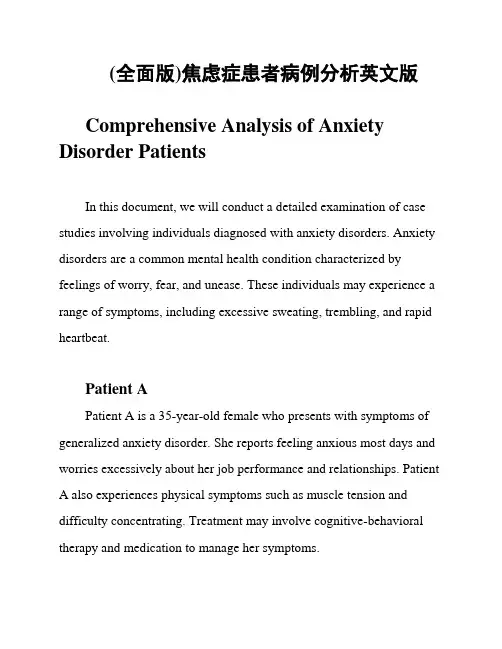
(全面版)焦虑症患者病例分析英文版Comprehensive Analysis of Anxiety Disorder PatientsIn this document, we will conduct a detailed examination of case studies involving individuals diagnosed with anxiety disorders. Anxiety disorders are a common mental health condition characterized by feelings of worry, fear, and unease. These individuals may experience a range of symptoms, including excessive sweating, trembling, and rapid heartbeat.Patient APatient A is a 35-year-old female who presents with symptoms of generalized anxiety disorder. She reports feeling anxious most days and worries excessively about her job performance and relationships. Patient A also experiences physical symptoms such as muscle tension and difficulty concentrating. Treatment may involve cognitive-behavioral therapy and medication to manage her symptoms.Patient BPatient B is a 25-year-old male diagnosed with social anxiety disorder. He avoids social situations and experiences intense fear of being judged by others. Patient B may benefit from exposure therapy to gradually confront his fears and build confidence in social settings. Additionally, support groups and relaxation techniques may help him manage his anxiety.Patient CPatient C is a 45-year-old male with panic disorder. He suffers from recurrent panic attacks characterized by sudden feelings of terror and physical symptoms like chest pain and shortness of breath. Patient C may benefit from therapy to address the underlying causes of his panic attacks and learn coping strategies to reduce their frequency and intensity.ConclusionAnxiety disorders can have a significant impact on individuals' daily lives and functioning. It is essential to provide comprehensive treatment that addresses both the psychological and physical aspects ofthe condition. By understanding the unique needs of each patient and tailoring interventions accordingly, healthcare professionals can help individuals with anxiety disorders lead fulfilling and productive lives.。
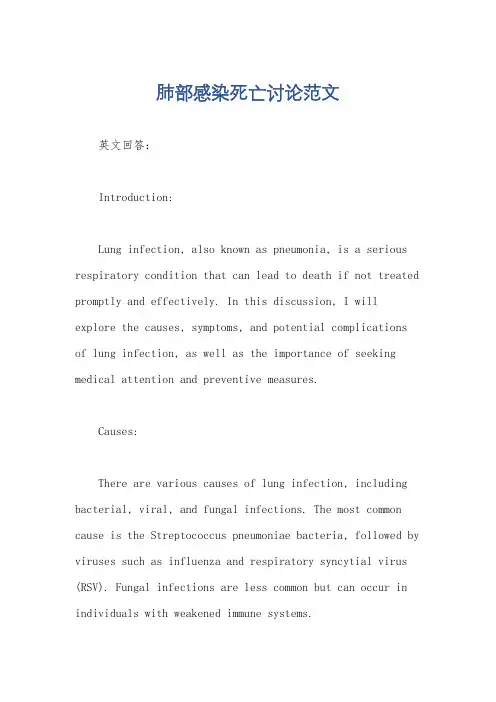
肺部感染死亡讨论范文英文回答:Introduction:Lung infection, also known as pneumonia, is a serious respiratory condition that can lead to death if not treated promptly and effectively. In this discussion, I will explore the causes, symptoms, and potential complications of lung infection, as well as the importance of seeking medical attention and preventive measures.Causes:There are various causes of lung infection, including bacterial, viral, and fungal infections. The most common cause is the Streptococcus pneumoniae bacteria, followed by viruses such as influenza and respiratory syncytial virus (RSV). Fungal infections are less common but can occur in individuals with weakened immune systems.Symptoms:The symptoms of lung infection can vary depending on the severity and type of infection. Common symptoms include cough with phlegm, fever, chest pain, shortness of breath, fatigue, and confusion in elderly individuals. In severe cases, the infection can lead to respiratory failure and sepsis.Complications:If left untreated, lung infection can lead to serious complications and even death. Some of the potential complications include lung abscess, pleural effusion, sepsis, and acute respiratory distress syndrome (ARDS). These complications can further compromise lung function and overall health.Importance of seeking medical attention:Seeking timely medical attention is crucial in managinglung infections. Antibiotics are often prescribed for bacterial infections, while antiviral medications may be used for viral infections. Prompt treatment can help prevent the infection from spreading and reduce the risk of complications.Preventive measures:Prevention is always better than cure when it comes to lung infections. Here are some preventive measures that can reduce the risk:1. Vaccinations: Getting vaccinated against bacterial and viral infections, such as pneumococcal and influenza vaccines, can significantly lower the chances of developing lung infections.2. Hand hygiene: Regularly washing hands with soap and water or using hand sanitizers can help prevent the spread of bacteria and viruses.3. Avoiding close contact: Avoiding close contact withindividuals who have respiratory infections, such as cold or flu, can reduce the risk of contracting the infection.4. Healthy lifestyle: Maintaining a healthy lifestyle, including regular exercise, a balanced diet, and adequate sleep, can boost the immune system and reduce the susceptibility to infections.Conclusion:In conclusion, lung infections can be life-threatening if not properly managed. It is important to be aware of the causes, symptoms, and complications of lung infections and to seek medical attention promptly. By taking preventive measures and maintaining a healthy lifestyle, we can reduce the risk of developing lung infections and protect our respiratory health.中文回答:引言:肺部感染,也称为肺炎,是一种严重的呼吸道疾病,如果不及时有效地治疗,可能会导致死亡。
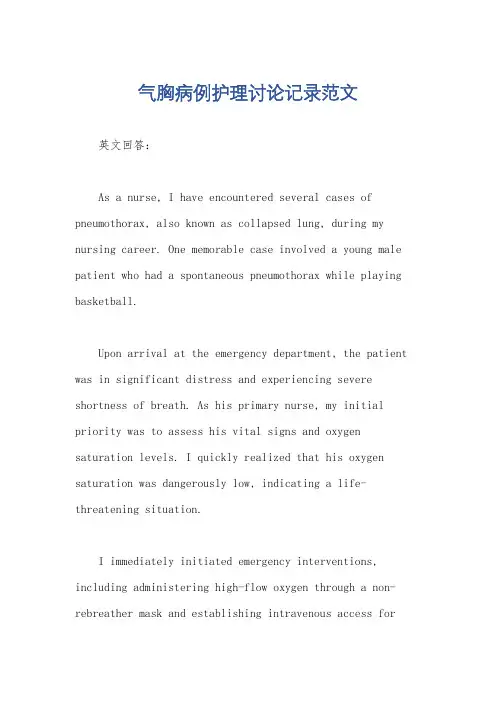
气胸病例护理讨论记录范文英文回答:As a nurse, I have encountered several cases of pneumothorax, also known as collapsed lung, during my nursing career. One memorable case involved a young male patient who had a spontaneous pneumothorax while playing basketball.Upon arrival at the emergency department, the patient was in significant distress and experiencing severe shortness of breath. As his primary nurse, my initial priority was to assess his vital signs and oxygen saturation levels. I quickly realized that his oxygen saturation was dangerously low, indicating a life-threatening situation.I immediately initiated emergency interventions, including administering high-flow oxygen through a non-rebreather mask and establishing intravenous access forfluid resuscitation. I also assisted the physician in performing a needle decompression to relieve the pressurein the pleural space and allow the lung to re-expand.Throughout the process, I maintained constant communication with the patient, explaining each step and reassuring him that we were doing everything possible to alleviate his symptoms. I used comforting phrases such as "Hang in there, buddy" and "You're in good hands" to provide emotional support and build trust with the patient.After the initial interventions, the patient's condition stabilized, and he was transferred to the intensive care unit for further monitoring and management. During his stay, I continued to closely monitor his vital signs, administer medications as prescribed, and provide emotional support. I also educated him and his family about pneumothorax, its causes, and preventive measures.Overall, caring for this patient with pneumothorax required a combination of clinical skills, effective communication, and empathy. It was crucial to provideimmediate interventions to stabilize his condition, while also addressing his emotional needs. By employing apatient-centered approach and using language that was both informative and comforting, I was able to establish a therapeutic nurse-patient relationship and contribute tohis recovery.中文回答:作为一名护士,在我的护理生涯中,我遇到过几例气胸(也称为肺部塌陷)的病例。
阑尾炎术前讨论记录书写范文英文回答:Preoperative Discussion Record for Appendicitis.Patient: Mr. Smith.Surgeon: Dr. Johnson.Date: October 10, 2022。
Dr. Johnson: Good morning, Mr. Smith. I understand you are scheduled for an appendectomy. Before we proceed, I would like to discuss the procedure and address any concerns you may have. Is that alright?Mr. Smith: Yes, Doctor. I have been experiencing severe abdominal pain, and my doctor suspects it might be appendicitis. I am ready to have the surgery if it is necessary.Dr. Johnson: Thank you for your cooperation. Appendicitis is an inflammation of the appendix, a small pouch-like organ located in the lower right side of the abdomen. The most common treatment for appendicitis is surgical removal of the appendix, known as an appendectomy.Mr. Smith: I have heard that appendicitis can be life-threatening if not treated promptly. Is that true?Dr. Johnson: Yes, that's correct. If left untreated, an inflamed appendix can rupture, leading to a serious infection called peritonitis. This can be life-threatening and requires immediate medical attention.Mr. Smith: What are the risks associated with the surgery?Dr. Johnson: Like any surgical procedure, there are risks involved. The most common risks include infection, bleeding, damage to surrounding organs, and adverse reactions to anesthesia. However, these complications arerare and can be managed effectively.Mr. Smith: How long will the surgery take, and what is the recovery time?Dr. Johnson: The surgery usually takes about 1-2 hours. After the procedure, you will need to stay in the hospital for a few days for observation and pain management. The total recovery time can vary, but most patients can resume their normal activities within 2-3 weeks.Mr. Smith: Will there be any dietary restrictions or lifestyle changes after the surgery?Dr. Johnson: Initially, you will be on a clear liquid diet, gradually progressing to solid foods as tolerated. It is important to avoid strenuous activities and heavylifting for a few weeks to allow proper healing. We will provide you with detailed post-operative instructions to ensure a smooth recovery.中文回答:和中文回答:阑尾炎术前讨论记录。